As knowledge grows about PFOAS and other forever chemicals in cookware, I get asked what the best non-toxic cookware and safest nonstick pans are for health all the time. In this guide, I review the best options for ceramic, cast-iron, and nonstick pans that are all completely safe to use.
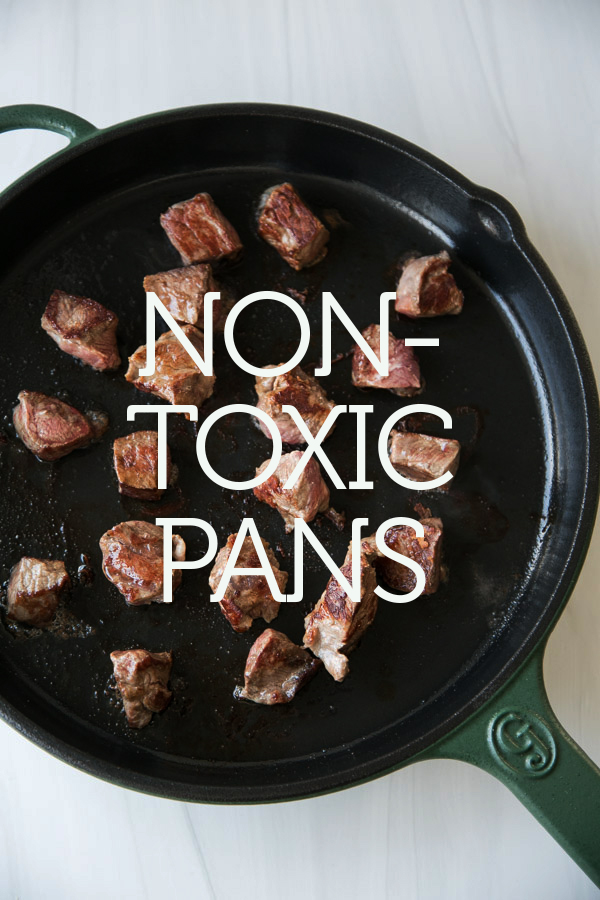
I include a list of pros and cons for each item, and also explain the cookware products you should avoid and why.
Here’s an overview of what we’ll cover:
- Are non-stick pans safe?
- Is Teflon still used in cookware?
- What is the safest cookware for your health?
- What cookware materials are not safe?
- The best non-stick non-toxic cookware brands
- The healthy hedonist final word
Are non stick pans safe?
Working as a private chef and teaching in people’s homes is an on-going anthropological experience that never ceases to fascinate me.
I can’t tell you how many times a client will tell me that they only use organic produce and grass fed meats, but when I arrive to cook it, the only pan in their kitchen is a flimsy nonstick skillet that looks like it made contact with a very feral feline. (Don’t worry, I’ll tell you the best non-toxic nonstick frying pan below)
Most of us know by now that Teflon and other nonstick coatings made up of perfluorooctanoic (PFOA) or acidpolytetrafluoroetheylene (PTFE) are a big no-no for your health. According to the Environmental Working Group, chemicals in this family (PFC’s) can cause birth defects, abnormal thyroid levels, liver inflammation and weakened immune defenses, among other issues.
So if you’re going to spend money on organic vegetables and grass-fed meat, does it make sense to go home and cook it on something that is just as toxic as pesticides? Mmm…better not.
The same logic applies to kitchen cleaning products, so when you’re done here, make sure to head over to my list of the best non-toxic cleaning products for your household.
Is Teflon still used in cookware?
As awareness has grown about the carcinogenic effects of PFOA, it’s been removed from many nonstick products on the market. But as the demand for safer options grows, so too does the second danger: “green” products that are no better than their chemical cousins.
The subject of nonstick cookware has been a huge challenge for me as a chef. I try to use it as little as possible in my own kitchen. But the fact of the matter is that there are some things you just can’t do as well without that freakish water-resistant surface. After all, I have better things to do with my time than spend the afternoon scraping congealed egg off my cast iron skillet.
Unfortunately, as I feared, many of the new “eco” models out there just don’t function as well as some of their toxic predecessors (many of them manufactured by brands who have been making cookware, toxic or otherwise, for years). Cooks Illustrated did one of their amazing hyper-anal evaluations of these pans and found that many of the ones I’d seen raved over on wellness blogs did not perform. And the ones that did turned out to be not much cleaner than generic alternatives. (Sigh of exasperation emoji).
So as someone who spends more time than most in the kitchen, and cares a lot about the quality of what comes out of there, but also has an autoimmune disease that’s forced me to put the kibosh on unnecessary chemicals, I thought it was high time I gave you my healthy hedonist take on this clean kitchen conundrum.
Recently, a few smaller direct-to-consumer brands have gotten in the game, and I’ve been quite pleased with the innovation. And since many of you may be spending more time in the kitchen and contemplating an upgrade, I thought I’d put together my list of favorites.
Read on for the best non-toxic cookware and safe nonstick pans, what to look for when shopping for clean cookware, and most importantly, how to USE these products in the safest and most delicious ways once home.
NON-TOXIC COOKWARE MATERIALS
What is the safest cookware for your health?
First let’s establish the safest materials that you should feel good about purchasing for your kitchen:
- Cast Iron
- Stainless Steel and Carbon Steel
- Ceramic (available as solid cookware, or as a nonstick coating)
- Glass (used mostly for bakeware)
- Silicone (seen in non-stick friendly utensils, and as a new “green” nonstick coating for pans)
If you’re not just looking for the best non-toxic nonstick frying pan, this list goes on. Terracotta and clay are also great materials for baking and fit the general philosophy that any material that’s been used for centuries of culinary delights, before convenience took the wheel of our consumer culture, are probably a safe bet for today.
What cookware materials are not safe?
As for the baddies, let’s take them one-by-one:
PFOA: This is the most notorious ingredient that put Teflon on the wellness angry heat map. It’s carcinogenic when under the duress of high temperatures, which one might think would be problematic for using in, um, cookware. Due to mounting concerns, the main manufacturer agreed to phase out this chemical by 2015. But many others in the PFC family still exist, and can be found in water resistant outerwear, stain-resistant carpets (and cleaners), fast food wrappers, popcorn microwave bags, among other sneaky places.
PTFE: A cousin chemical to the above, and also used in Teflon and other nonstick coatings. According to EWG, the issue of this chemical flaking into your food is a secondary concern to what it does to the air around you. When placed over a high flame, the coating begins to breakdown and emit such toxic fumes that they’ve been known to kill pet birds in the vicinity (poor Polly!). Humans experience flu-like symptoms from exposure.
Aluminum: While the flecks themselves might be innocuous, tearing nonstick coating does create a secondary problem: the small matter of what lies beneath them. That material is often aluminum. Back in 1970, researchers found a connection between the aluminum in our diet (mostly from canned food) and the development of Alzheimer’s disease. Like any heavy metal, aluminum slowly builds in your body. So small daily doses do eventually add up. Outside the kitchen, I’ve begun limiting my exposure by switching to natural toothpaste and deodorant, since many contain aluminum.
In the kitchen, I buy aluminum-free baking powder and don’t drink bubbly water or soda out of a can (though, how this stacks up to plastic bottles in the grand scheme of things, I don’t know). To mitigate the issue for cookware, manufacturers have created a new process of “anodized aluminum” which is said to be nontoxic and heat resistant. But some aluminum does still leach into the food, even if it’s less.
I still use aluminum baking sheets, but I’ll always cover them in parchment paper rather than have the food in direct contact (as does my pal Pamela). This is also just plain easier for cleanup, and if I’m being honest, this practice began more from laziness than for my health. Aluminum foil tears easily, so it’s not great for lining pans that you don’t want to get messy. I still use it for a few things, like roasting beets, but otherwise, parchment all the way.
THE BEST NON TOXIC NON STICK COOKWARE BRANDS
When I was researching nonstick pans, I weighed the options across the following healthy hedonism criteria: functionality, affordability, and toxicity. Unfortunately, there’s always some give and take across the board in these areas. And at the end of the day, I’m not sure it’s worth throwing out all your old nonstick pans. It’s just a matter of using them in a safer way. Scroll to the end of the post for what regular nonstick items I’ve kept in my home, and how I’ve avoided the worst effects of them.
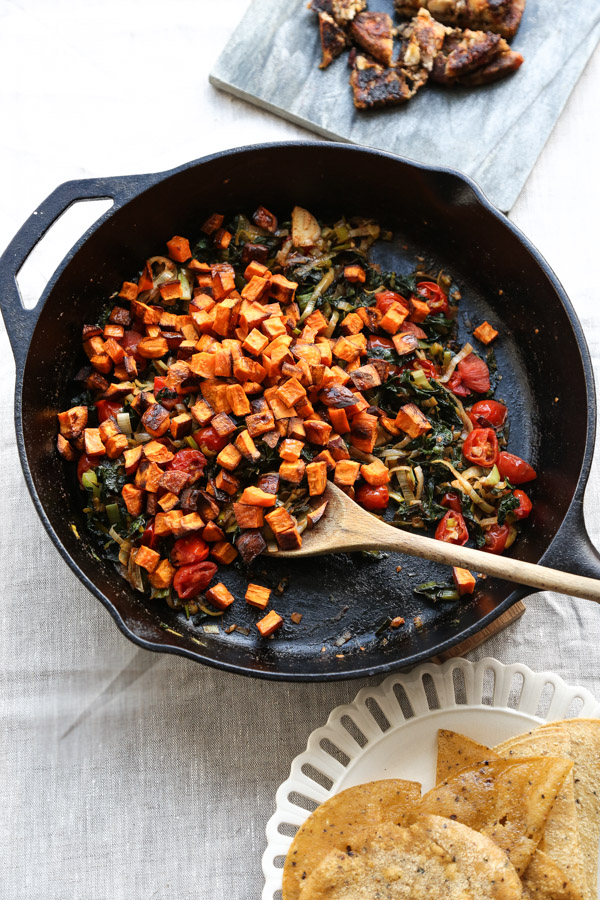
Lodge Cast Iron $
Pros: I won’t beat around the bush and make you read to the end of the article to give you my verdict. These multipurpose cast iron skillets (and Dutch ovens) are the best bang for your buck, and what I use for the majority of my stovetop operations. Salty Southern grandmothers have known that these are the best non-toxic nonstick frying pan for generations. When cared for properly, they develop a seasoned patina that is naturally nonstick. And the good news is, they actually leach something good into your diet: iron! My favorite is the 15-inch for roasts, frittatas and searing protein. It also doubles as a casserole or paella pan. I keep a smaller one on hand for frying eggs, which requires a level of heat that I’m not comfortable using on any nonstick, no matter how green the claim.
Cons: Some people find these pans annoying to clean since you can’t use soap. But once you get used to the seasoning process, your food will taste so much better for it. Here’s a little how-to I wrote in the early days of the blog. People talk about how you shouldn’t use high acid ingredients like tomatoes on cast iron since it messes with the PH and will give you a metallic flavor. I’ve honestly have never had this problem and have cooked a variety of things from this to this using tomatoes.
What to buy: Lodge 15-inch Pre-Seasoned Cast Iron Skillet
Where to buy: Amazon | Food52 | Williams Sonoma | Dick’s Sporting Goods
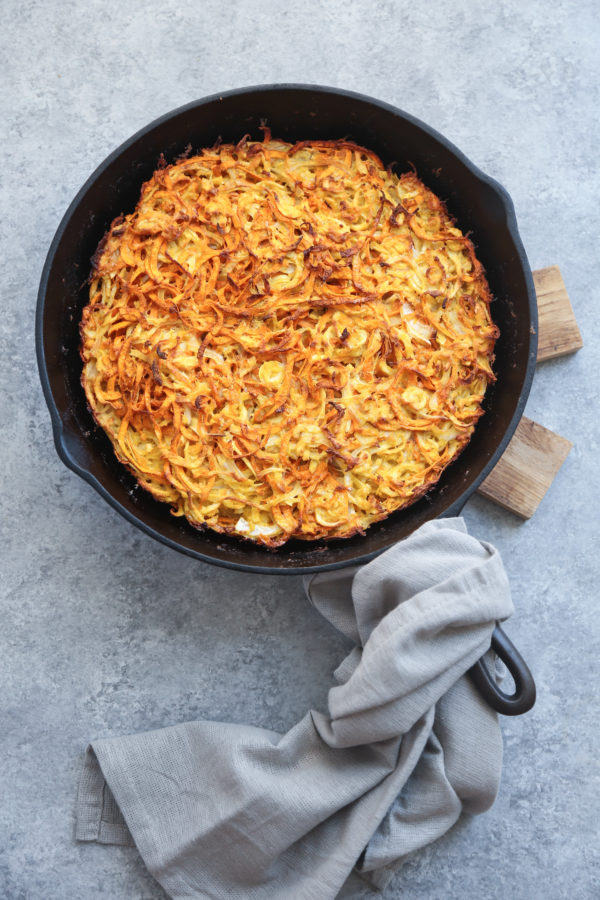
Le Creuset Enameled Cast Iron $$$$
Pros: These Le Creuset pans are the high end, spiffed up version of the above. (Think Carrie Underwood in 2005, versus Carrie Underwood now.) Not only is the bottom coated in their signature enamel (in a variety of colors) but the cast iron cooktop uses a coating that makes it dishwasher safe (i.e. you can use soap).
Cons: While I love my Dutch oven, as far as nonstick skillets are concerned, I’m not sure the enameled versions are worth the upsell. I’ve found that these pans are better maintained when you treat them like true cast iron (skip the dishwasher, and rub with oil after each use). But if you can afford it, you’ll be very pleased! Most traditional nonstick skillets have plastic handles and aren’t made to go in the oven. Lodge and Le Creuset items can do it all, and will last a lifetime.
What to buy: Le Creuset Signature Enameled Cast-Iron 7-1/4-Quart Round French (Dutch) Oven
Where to buy: Amazon | Food52 | Saks Fifth Avenue | Williams Sonoma
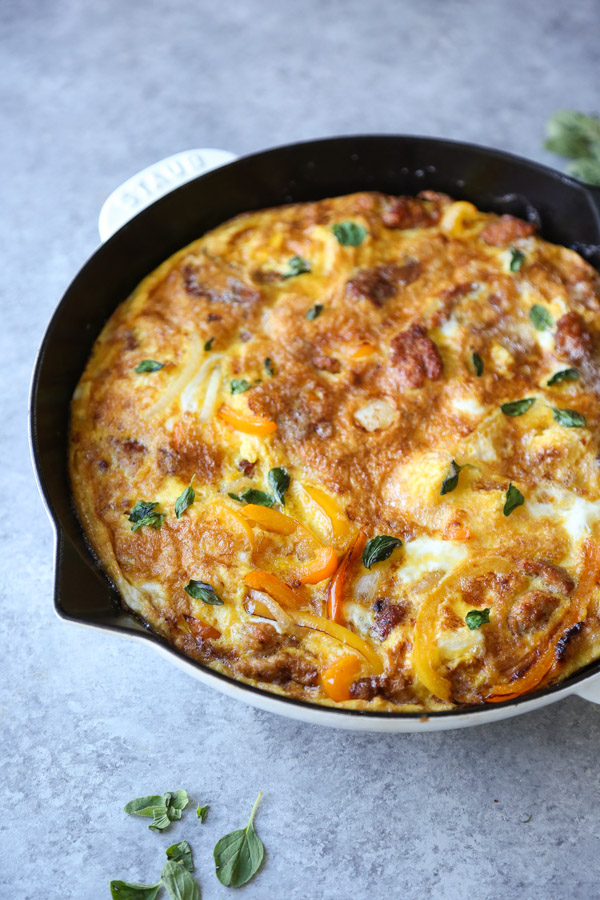
Staub $$$
Pros: Similar to the Le Creuset, Staub uses enameled cast iron that can withstand soap. It tends to be slightly cheaper than Le Creuset, but with similar quality. I own the white fry pan and the perfect pan, which I use a TON as a wok for stir fries.
Cons: Like the Le Creuset, I find that my Staub pans behave better when I oil them and don’t use soap, similar to traditional cast iron natural coatings.
What to buy: Staub 12-inch Cast Iron Fry Pan
Where to buy: Amazon | Food52 | Williams Sonoma |
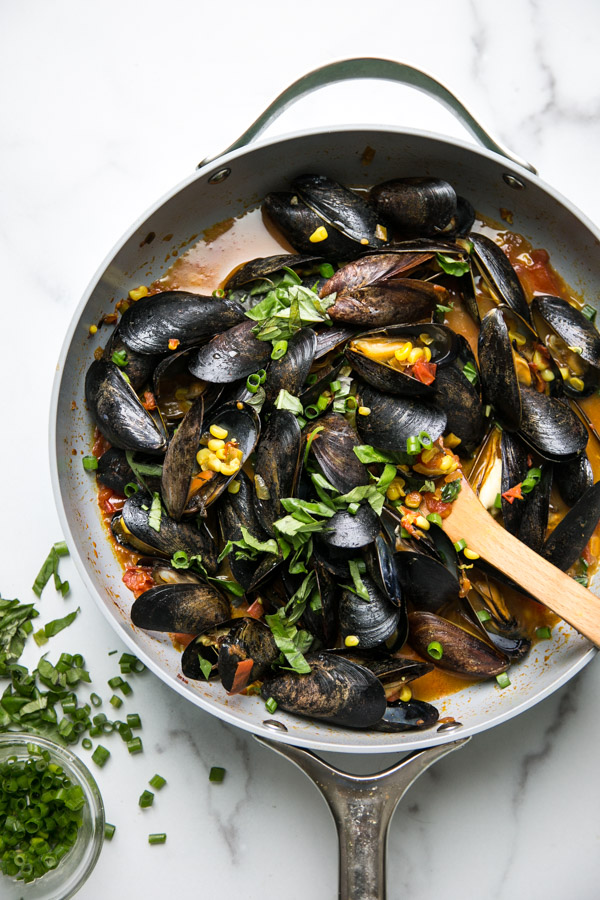
Caraway Home $$
Pros: This new player on the scene makes thoughtfully designed non stick sets using ceramic coating. The four pans on offer retail for $395 together, which is on the higher end, but a great deal for the value. The set comes with a magnetized rack for easy storage and a canvas lid case (see below) that can be hung on a wall or inside a cabinet door. I’ve been using these pans now for 6 months in a very small kitchen and have been impressed. Not only does nothing stick to them, but the pans are oven safe as well up to 600 degrees F. If you want a lighter pan than traditional cast iron that can still go in the oven, this would be my pick. Plus, the color palette is fun and chic! I have the set in sage.
Cons: Like some of the other non stick options below the coating sits atop aluminum, which is why it’s still not recommended to use metal utensils with these pans.
What to buy: Caraway Ceramic Nonstick 4-Piece Cookware Set
Where to buy: Caraway
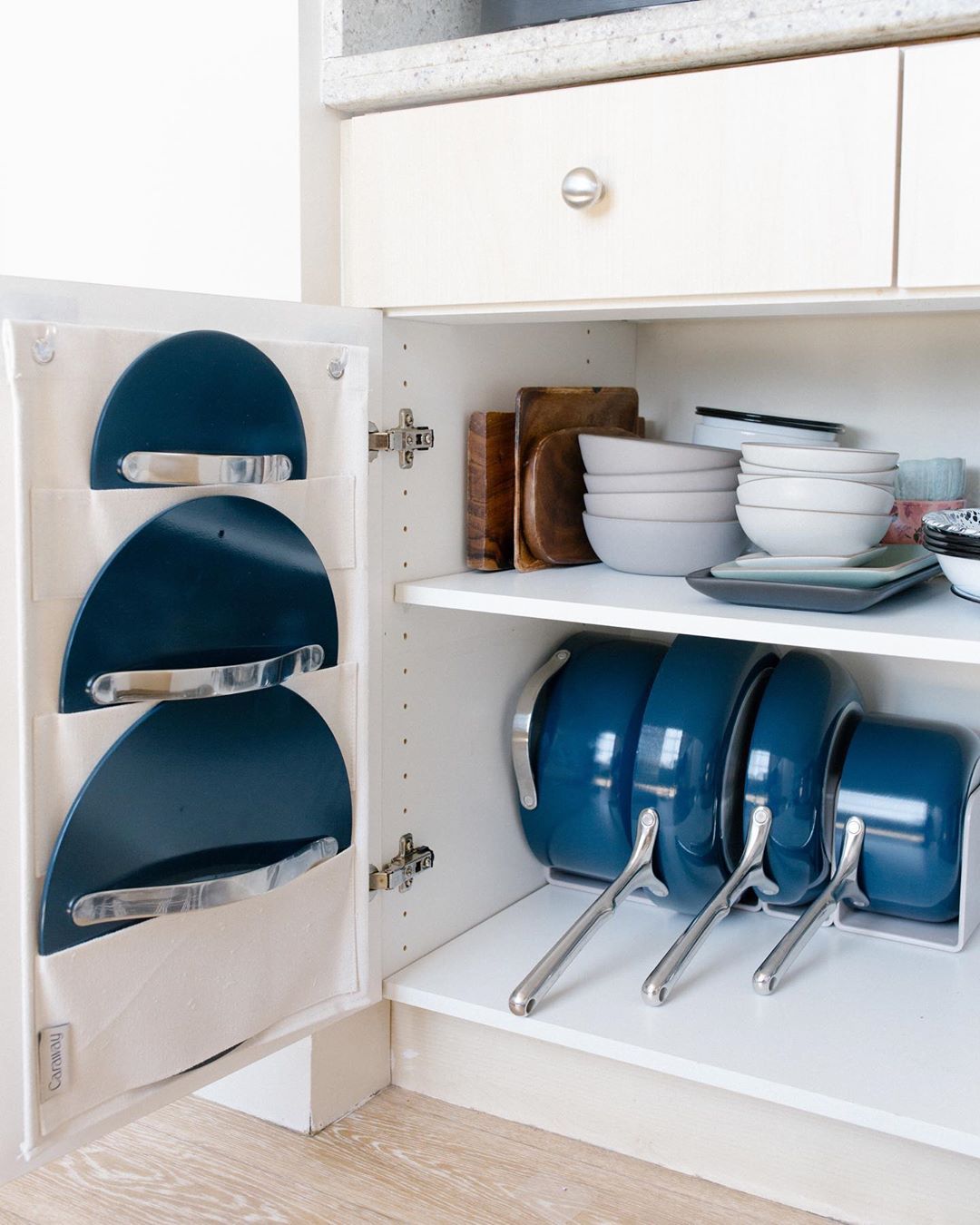
Great Jones $$
Pros: Another new comer on the scene, this woman-owned business makes incredibly chic ceramic cast iron that is the best of all worlds. They are truly comparable in quality to Staub and Le Creuset, but half the price. I love the thoughtful features that are a welcome update on the old classics: handles that are large enough to grip with oven mitts (see image below), brass hardware, and a matte finish that you won’t find anywhere else. I had been seeing these pans advertised on instagram for months and finally decided to try the braiser in broccoli green. It’s a perfect size and shape, and really feels substantial / long lasting. I will also say that I love the bakeware! It’s really hard to find non-aluminum baking sheets and trays that are heavy-duty and good quality.
Cons: The braiser is quite heavy (which I like), but I know that bothers some people. I don’t find this set quite as easy to clean as Caraway but the quality is great.
What to buy: The Dutchess or King Sear
Where to buy: Great Jones
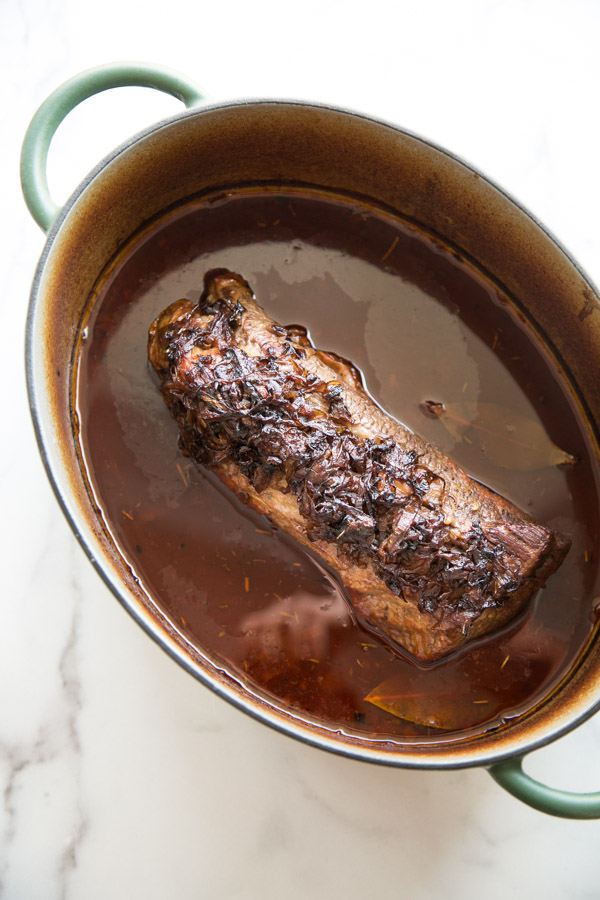
Recommended with reservations:
Ballarini $$$
Pros: These professional-grade pans are on the more affordable side and definitely chef-approved for their cooking quality. They are made in Italy and therefore subject to Europe’s more stringent toxicity standards. The coating is a patented mineral-ceramic mix. I bought this pan for my mother-in-law for Christmas and she loves it.
Cons: Though their website says you can use metal utensils, since it’s an aluminum base, it’s not recommended.
GreenPan $$$
Pros: I used these pans extensively at one of my client’s homes, and found them to be fairly easy to clean at the beginning. They got more brittle as time went on, which was a lot more noticeable on the tan surface than it would have been on one of the darker pans. The coating is ceramic, with anodized aluminum base, so the fact that it scratched was a little more worrisome. So far I have found the Caraway models much more durable and easier to clean.
Cons: Overall, I would have to agree with the CI assessment: the pans were great for sautéing but didn’t radiate enough heat to properly sear fish or steak. For a small omelet pan though, the 8-inch would work just fine.
Carbon Steel $$
Carbon steel is a perfect hybrid of a cast iron skillet and a stainless steel frying pan. It has a cast iron’s heat retention, seasoning, and non-stick properties and stainless steel’s heat control, lightness and cooking speed. For those who find cast iron too heavy, this is a great option. For those who want true nonstick without the need for any maintenance, go with something like Caraway.
Xtrema Ceramic Cookware $$$$
Pros: This is the one pan that actually might be as green as it says it is. No coating necessary, the Xtrema cookware is 100 percent solid ceramic. I included this pan on my list mainly because Katie raved about it, and because it’s the highest on the clean scale. I think the best product is this 10-inch braiser. It would work like a skillet, baking pan, or Dutch oven.
Cons: Unfortunately, one virtual glance at these pans and I was skeptical. They don’t look at all like normal skillets. The sides are too straight, more resembling a saucepan than something that would be easy to use for sautéing. Also, as even Katie noted, they break and chip easily, like any glass or ceramic products. But I think the biggest knock is that they’re expensive. If I’m going to be dropping this type of cash (quiche), I’d much rather just invest in a LeCreuset.
I should also note that Scanpan rated the highest in functionality across the board by both CI and The Wall Street Journal. But considering it uses PTFE still, I don’t think it’s worth spending $140 just to go from two toxins to one.
Healthy Hedonist Final Word
There is really only one task that a nonstick cast iron skillet can’t perform well: scrambling eggs, or the extended version of that, making omelets. A second, is homemade veggie burgers, which tend to be very fragile. I use my large and small cast iron skillets for anything else—searing delicate fish, making frittatas, and pretty much everything in between. For those pesky eggs, I use the Caraway small skillet.
The best non-toxic nonstick frying pan is really the one that’s used properly, which is arguably not for frying at all. If you’re unsure of the safety of a nonstick coating, avoid high heat and metal utensils though at all costs.
A scratched pan that has been begging you to replace it for years is one thing. But I wouldn’t worry about replacing your whole nonstick arsenal overnight. If you want the convenience of nonstick cooking for certain foods, there’s no point in switching to an alternative that’s just marginally safer, and might not give you the convenience you were after in the first place. The key is to use these pans less, and use them right. For a low and slow scramble on weekends, you’ll probably be fine using whatever you have.
The other element is making sure you are using non-toxic cleaning products on your pans after you use them.
Are you completely outfitting your new kitchen or making a wedding registry? Well make sure to also check out my post on the best knife block sets and tips on how to organize your kitchen cabinets!
What do you use in the kitchen? Do you care more about functionality or toxicity? How do you weigh both? Would love to hear from you in the comments!
Need help finding lifestyle changes that last? Let’s work together to find your path forward. My 4 Weeks to Wellness Course might just change your life. With 4-weeks worth of recipes that are gluten, dairy, corn, soy and refined sugar free, not to mention tasty AF, it’s a perfect way to explore your food sensitivities and heal inner and outer chaos.
DISCLOSURE: This post may contain affiliate links, meaning when you click the links and make a purchase, we receive a commission at no cost to you! As always, opinions are 100% my own and I would never endorse or link to a product I didn’t love.

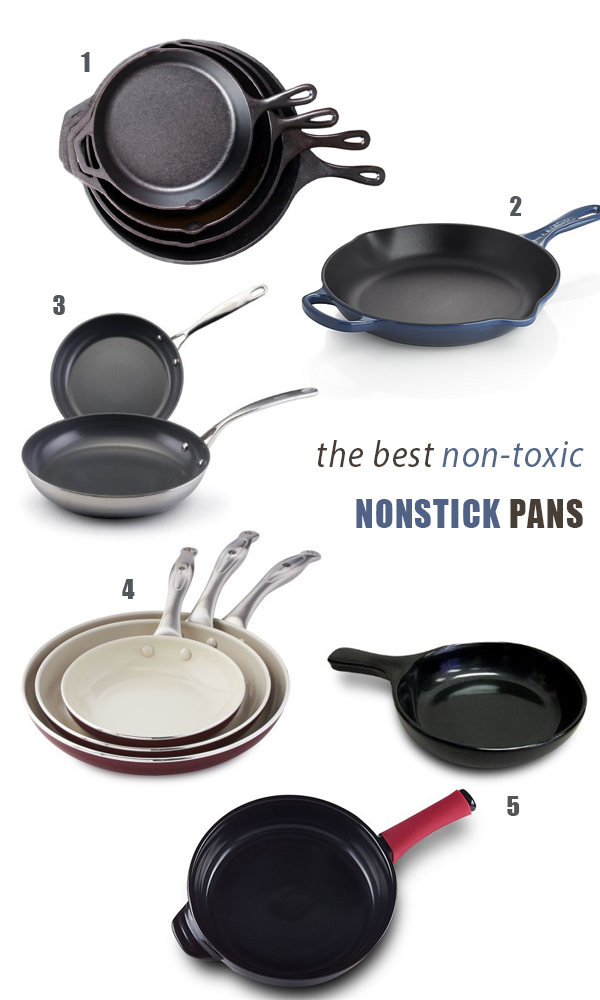
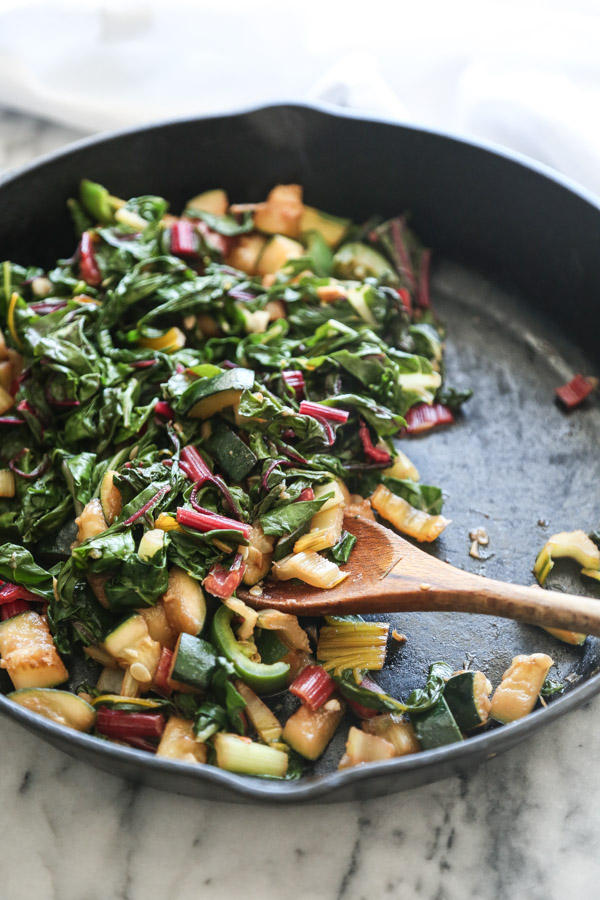

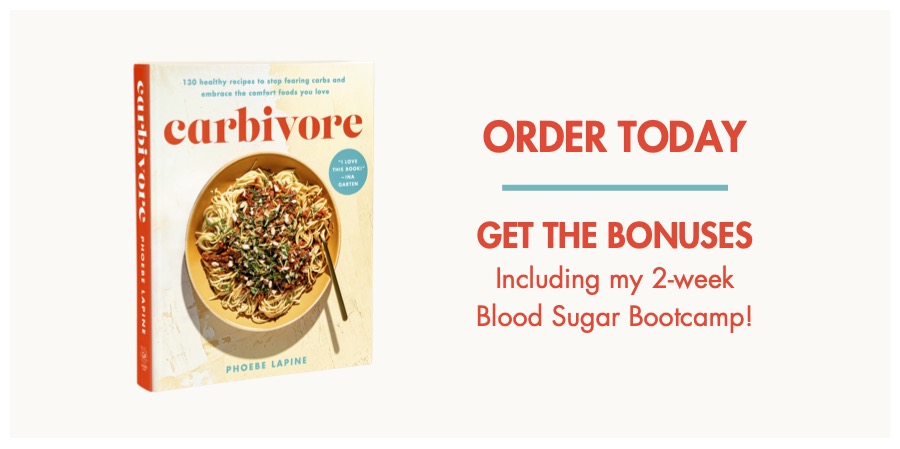
Such a thorough report, Phoebe! Definitely sharing this with my readers. Thank you!
yay!! thanks Pamela!! I loved your post on parchment paper. with you lady. xo
Funny I have no problem with scrambled eggs and omelets in my cast iron skillet, but the oil has to be on the hot side and you have to work fast. My one complaint about the iron pans is that they’re too heavy to flip an omelet, for example, or shake. As for aluminum I’m totally in your camp. Not only soda cans and deodorants and cookware and wrap are verboten in my house but even antacid or anti-gas tablets like Tums contain plenty of this toxic metal. Folks, it’s like going out of your way to eat lead!…And I’ve always felt wary of buying non-stick. Thanks, Phoebe, for this list!
yes – the medications people don’t realize! thanks for sharing.
I do exactly what you do when it comes to nonstick…eggs only. Everything else goes in cast-iron, ceramic-coated, or stainless steel. Until I start getting lazy and let my nonstick usage increase unnecessarily. I guess it’s time to recommit to my other cookware again!
hehe we are in the same boat hannah! i caught myself the other day pulling the nonstick out for something else and had to do a little slap on the wrist.
Does besamware have these problems
Great summary of the cooking pluses and minuses for pans. I recently ran across an article about carbon steel pans and have been experimenting with them. They weigh almost as much as cast iron, but have a smoother cooking surface. I haven’t manage to season them to surface that is completely non-stick for eggs the way the article claims but I’m working on it….
Here’s the article reference: http://www.cooksillustrated.com/equipment_reviews/1623-carbon-steel-skillets?ref=new_search_experience_3&incode=MCSCD00L0
I was wondering how that was going for you! The seasoning process looks quite intensive. But they are beautiful!
There are light weight carbon steel pans available too from Made In but haven’t personally tried them: https://madeincookware.com/products/blue-carbon-steel-kit?variant=29058188705871
For those of us unable to lift the cast iron or Le Creuset pans (even when empty), non-stick pans are great. I do not like to clean stainless. I spend enough time cooking, which is not easy for me, and want easy cleanup.
I was once gifted with a LeCreuset roasting pan. Everyone was raving about how much better stews, etc are in them. So I tried my favorite stew (usually made in a non-stick Dutch oven). Well, I could taste absolutely NO DIFFERENCE except that the cleanup was horrible. So I re-gifted the pan! Sometimes being “in” is not always smart.
definitely important to note about the heaviness factor if that’s an issue for you. thanks for chiming in joanie!
This is a very informative post and it will help when someone buys non-stick pans. I regular visit your site. My request is you can post with some real customer reviews so that who wants to buy, they will get a clear idea about the product. I hope you will post a more informative article in future.
Thanks
Hi Phoebe, Regarding your question my only concern is toxicity. If it is going to make me sick, I do not care how functional it is.
I am new to your site and I am an immediate fan. I really like your intelligent and thorough writing style. I also like how your charming personality is expressed through your writing.
I am looking forward to seeing your future articles.
Thank You,
Scott
that is so kind Scott. Thank you for the compliments!!
Is the GreenPan suitable for omeletting the eggs? The coating of GreenPan is ceramic, with the anodized aluminum base, so it means it can’t be used on induction cooktops, can it?
I’m not positive Lita in terms of induction. I thought most pans worked just not copper bottoms. I have made an omelet on a greenpan and it behaved!
I’m getting really tired of scraping stuck food (such as veggie burgers) off my GreenPan – I don’t recommend them.
good to know…thanks elaine
Reading your informative guidelines to cookware I want to just say
a big Thank you. I have spento so much time trying to decide on the best cookware. What is your opinion on Kitchen craft waterless cookware?
I have a family member who has her set for a little over 20 yrs.
Thanks again
Annette
you’re so welcome! i’m not familiar with it sorry!
Thanks for this Phoebe. I was wondering what alternatives there are to cast iron? My 82 year old mother insists on using it for everything. But it’s getting to heavy for her to lift. Any safe, and light options?
Thanks,
John
This is super helpful! Thanks for the informative review. I use only cast. iron, but I have been looking for an alternative for eggs becuase they are always so messy in my cast iron! I still don’t know if I’ll get a green pan or something else. I’ve also heard that the WearEver Nonstick Ceramic Coated pans are good.
I would have liked to see you include the old fashioned copper pots by revere ware in this. Omelet and scrambled. Not so difficult to clean up after interior with old fashioned chore boy copper scrubbers and external cleaning with lemon and salt. Dry before allowing to spot. I love my lodge cast iron and need more pieces but absolutely spend what ever is necessary for a good set of old fashioned copper pots.
Thanks so much for sharing this information. My preference is to use a cast-iron skillet for cooking scrambled eggs. Most people struggle with scrambled eggs. I find it really easy and fast breakfast. Heat up the pan to medium-high and then put about a tablespoon of Irish butter in the pan. I then break the eggs directly into the pan and break the yokes. Just stir continuously until cooked. That’s it.
No other pan can compare to my well seasoned cast-iron pans. thanks again for the information.
Hello, I enjoyed your article. I have mainly Xtrema pots and pans in the kitchen. I do like them, only downsides are that they take longer to heat up than others, they are breakable, and after some time them get brittle and need replacing, but the warranty for this with regular usage seems to be great. I have had some pots replaced without any issues. I also have Lodge enameled huge pasta and soup type pots and I really like these. I have had it replaced, free as well, when the enamel did chip off after time. I also have 3 cast iron skillets that I love. I use them for eggs, omelets, anything but tomato dishes. They are so well seasoned, that nothing sticks and food just slides right off. No downside. Oh, for baking sheets, I have stoneware from pampered Chef. Great stuff except for breakage.
I was considering getting a nonstick Le Creuset pot to try but wasnt sure if those nonstick ones were safe.
Exactly what I needed right now. Thanks for sharing, this is a very comprehensive and useful list!
I just finished your book and of course, this was my next stop. Please stop using your non-stick for eggs. Please. Just. Stop. I do all my eggs on a Lodge flat, round griddle. Perfection every time. The secret is lots of bacon grease (I’m a Southerner and everything start with bacon grease. After, I wipe it with coconut oil.) So, glad I “discovered” you book…I’m scheming on a Project of my own now!!
I use my own non-stick preparation on all of my pans: Le Crueset, stainless, pyroceram (I have some of the original skillets from Corning Ware), cast iron, and my one and only carbon steel wok. It is a combination of coconut oil and organic sunflower lecithin. I keep a jar on my counter so that it isn’t hard. I use a silicone brush to spread a very thin coat on the pan–even sauce pots. I give them a slight pre-heat and I love the results. I have had pans that looked terribly burned if I did not deglaze, but amazingly a good spray rinse made them dishwasher ready–“sparkle” However, if you are fat phobic that won’t work for you. I use it even if I plan to use other fats.
Great report. Thank you.
My family has had special needs. Lots of brain tumors. We worked closely with a world renown bt nutritionist on diet and cooking. Many bt patients have extremely high iron levels. She cautioned against cast iron skillets for this condition. Our alternative for the past 16 years has been glass. Corning Visions. We do eggs and omelettes in the skillet quite effectively, although we are not professional cooks. We have used all these years and it is just now wearing out on the surface. Your article is timely as we will be shopping for the kitchen when this crisis is over.
THIS ARTICLE IS AMAZING!! I’ve been trying to research non-toxic cookware; comparing the cost and functionality. I like cast iron and stainless steel but you can’t exactly fry an egg on them. Le Creuset is wayyyy out of my budget. I’ve been hearing good thinks about Caraway but seemed like too new of a brand to
tell how it holds up over time. Overall, this article was beyond insightful so thank you!
This helped so much! What about hard anodized pans? I have several Calphalon hard anodized and I’m now concerned about toxic chemicals. Is this safe?
And if possible what is the best non toxic of course, Wok and boiling pot for soups and such?
Thank you!
Great list! i bought one of them. thank you so much
I did not see stainless steel on the list?
I have stainless steel cookware that is nonstick, toxic free, green manufacturing, sustainable, hand crafted, and Made in the USA.
if you would like to know more, please email me.
Great article indeed. But I have a question. Is there any risk if we use a pan at the recommended heat by the manufacturer?
Thanks for sharing this article and your analysis, it’s been very helpful. Any experience with Lodge enameled cast iron?
Hello. Looking into the Ballarini non-stick pans (one of your recommendations), it looks like their non-stick coating is made of PTFE. This is from their website (https://www.zwilling.com/us/ballarini/cookware/):
“The most updated nonstick coating systems are used to fabricate Ballarini’s premium cookware. Made from PTFE (polytetrafluoroethylene), this PFOA-free polymer guarantees the best possible nonstick performance and is certified safe by international health professionals.”
I looked at the Parma Plus and the Parma line. Is there a different Ballarini pan that doesn’t include PTFE?
I am trying to find toxin-free cookware. Made-In Nonstick says it is toxin-free on its website but then only states that it has no PFOAs. Do you know whether it has PTFE?
Very useful information. I’ve been wondering what to buy and this gives me the information.
thank you Unka!!! Miss you!
This was such a great informative article and timely since I’ve moved and downsizing a lot of my kitchen! I LOVE my cast iron skillets and have 3 in different sizes! My only concern with using them to sear anything, they create a lot of smoke even though they are well seasoned. This is a major issue in my smaller home, as all my smoke detectors are wired together and if one goes off, they ALL sound the alarm! In the winter months, I like to cook steak indoors but have had trouble producing way too much smoke. I tried a reverse sear method in a green pan I have and that did seem to work but took a bit longer for a well done steak. Would a carbon steel work for this? What skillet would you recommend?
Thank you!
Yes, I think carbon steal would be the best bet. You can also try some of the treated cast iron (ones you can use soap on) like the staub or great jones.
Seriously invention of a nonstick pan is a revolutionary step in the cookware. I really love those when I cook with non-stick cookware. Thanks for sharing insightful thoughts.
Happy cooking!
Hi. Just a head’s up that Tamara Rubin (Lead Safe Mama) would not approve of most of your suggestions because of lead and cadmium among other issues. I ended up getting rid of my Le Creuset because of her and now she is saying that All Clad may have mercury. It is a very upsetting thing to find non toxic products. For glass pots there is the Italian KnIndustrie pots.
Very good information that I’ve tried hard to follow. I laugh when I think about pre-non-stick. My mother and grandmother certainly made scrambled eggs for me without non-stick. Of course, it was probably in a Wearever Aluminum pan! Ugh!
The one thing I want to bring to your attention is the danger of cast iron for anyone with iron loading genes, Most of us have no idea we may even have one of those genes because it often doesn’t show up on a normal iron test, but with one of those genes, iron loads in the heart, liver, pancreas, skin, brain, almost everywhere and it’s dangerous to say the least. Since it is called the Celtic Curse, if you have any Irish ancestry, be cautious! On the other hand, it’s believed it may have come from the Vikings and is quite common among people of Scandinavian descent also, but is certainly not limited to those. People who know they have an iron loading gene are told not to use cast iron cookware.
If for some reason Mr Arturo Inquinito is still gathering information.. I’m more interested with the enamel coated square pan (10 or 11 square inches) with a flat (ultra flat) bottom. It’s for my pancakes and bacon in the morning.